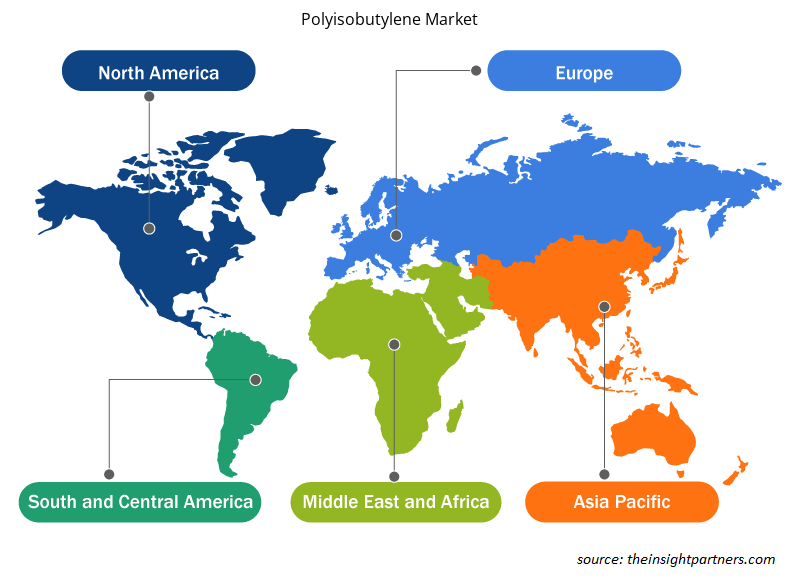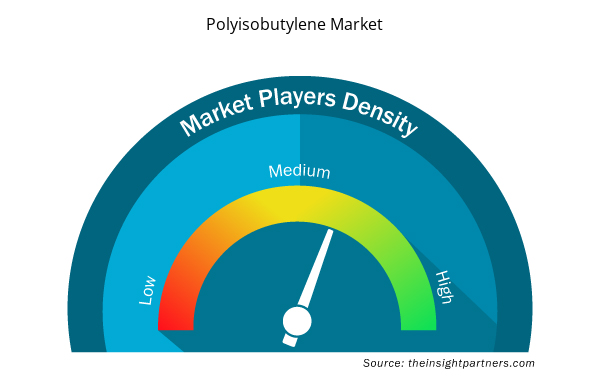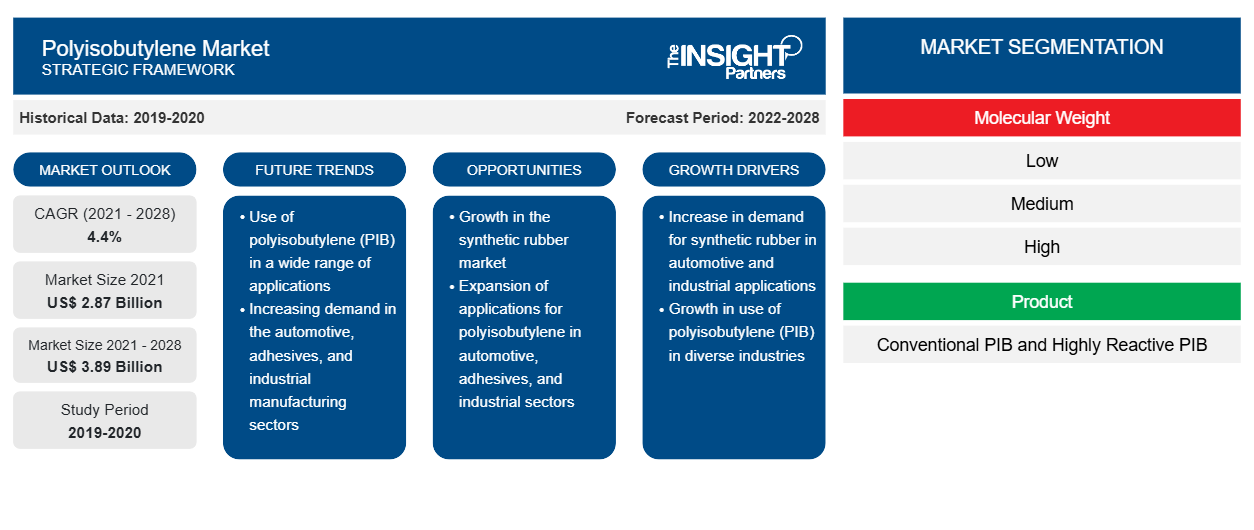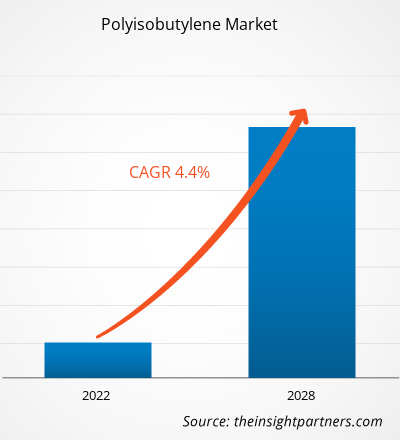[Forschungsbericht] Der Polyisobutylenmarkt wurde im Jahr 2021 auf 2.871,14 Millionen US-Dollar geschätzt und soll bis 2028 3.891,16 Millionen US-Dollar erreichen; es wird erwartet, dass er von 2021 bis 2028 mit einer durchschnittlichen jährlichen Wachstumsrate von 4,4 % wächst.
Polyisobutylen (PIB) ist ein Elastomer oder ein synthetischer Kautschuk. Nach Molekulargewicht ist der Markt in niedrig, mittel und hoch segmentiert. Es ist eine vielseitige, ungiftige und wasserhelle viskose Flüssigkeit. Polyisobutylen kann die Klebrigkeit erhöhen, wasserabweisend machen, den Viskositätsindex verbessern und eine hervorragende elektrische Isolierung bieten.
Im Jahr 2020 hatte Nordamerika den größten Umsatzanteil am globalen Polyisobutylenmarkt . Steigende Anforderungen aus verschiedenen Anwendungen wie Transport, Agrochemie, Elektrik und Klebstoffen treiben das Wachstum des Marktes in Nordamerika voran. Polyisobutylen wird zunehmend in der Transport-, Lebensmittel- und Bauindustrie eingesetzt, da es eine geringe Gasdurchlässigkeit, ausgezeichnete Zugfestigkeit, hohe chemische Beständigkeit und erhöhte Steifigkeit bietet.
Passen Sie diesen Bericht Ihren Anforderungen an
Sie erhalten kostenlose Anpassungen an jedem Bericht, einschließlich Teilen dieses Berichts oder einer Analyse auf Länderebene, eines Excel-Datenpakets sowie tolle Angebote und Rabatte für Start-ups und Universitäten.
- Holen Sie sich die wichtigsten Markttrends aus diesem Bericht.Dieses KOSTENLOSE Beispiel umfasst eine Datenanalyse von Markttrends bis hin zu Schätzungen und Prognosen.
Auswirkungen der COVID-19-Pandemie auf den Polyisobutylenmarkt
Die COVID-19-Pandemie hat den Status des Chemie- und Materialsektors drastisch verändert und sich negativ auf das Wachstum des Polyisobutylenmarktes ausgewirkt. Die globale Chemie- und Materialindustrie ist eine der wichtigsten Branchen, die unter schweren Störungen der Pandemie leidet, wie z. B. Unterbrechungen der Lieferkette, Absagen von Technologieveranstaltungen und Büroschließungen. Die von Ländern in Europa, Asien und Nordamerika verhängten weltweiten Reiseverbote beeinträchtigen die Möglichkeiten für Geschäftskooperationen und Partnerschaften. All diese Faktoren werden sich voraussichtlich negativ auf die Elektronik- und Chemie- und Materialindustrie auswirken, was das Wachstum verschiedener mit diesen Branchen verbundener Märkte behindert. Da die Volkswirtschaften jedoch planen, ihre Aktivitäten wieder aufzunehmen, wird erwartet, dass die Nachfrage nach Polyisobutylen weltweit steigen wird. Die Nachfrage nach Polyisobutylen aus den nachgelagerten Sektoren für Industrieschmierstoffe und Schmierstoffzusätze hat mit der Wiederaufnahme der Geschäftstätigkeit und der Aufhebung der Lockdown-Maßnahmen weltweit zu steigen begonnen. Markteinblicke Die
Automobilindustrie wird das Marktwachstum im Prognosezeitraum ankurbeln
Für die Automobilindustrie ist die Leistung der Motoren für ihre täglichen Aufgaben wichtig. Die Automobilindustrie ist seit vielen Jahren der wichtigste Markt für verschiedene Arten von Kraftstoffzusätzen . Der Anteil der Automobile ist aufgrund des Mangels an effizienten Alternativen zu fossilen Brennstoffen und einer wachsenden Mittelschichtwirtschaft kontinuierlich höher als der anderer Marktsegmente für Kraftstoffzusätze. Die relative Bedeutung der Luftfahrt für Kraftstoffzusätze hat in den letzten Jahren zugenommen, was letztendlich die Nachfrage nach Polyisobutylen erhöht hat.polyisobutylene.
Anwendungseinblicke
Basierend auf der Anwendung ist der globale Polyisobutylenmarkt in Reifen, Industrieschmierstoffe und Schmierstoffzusätze, Kraftstoffzusätze, Klebstoffe und Dichtungsmittel und andere unterteilt. Das Segment Industrieschmierstoffe und Schmierstoffzusätze hatte 2020 den größten Marktanteil. Polyisobutylen (PIB) reagiert mit Maleinsäureanhydrid zu Polyisobutenylbernsteinsäureanhydrid (PIBSA), einem Grundbaustein für Dispergiermittel in Schmierölen und Reinigungsmittel in Kraftstoffen. Seine andere Variante Polyisobutylensuccinimid (PIBSI), abgeleitet von Polyisobutylen (PIB), wirkt als antioxidativer Emulgator in löslichen Metallbearbeitungsflüssigkeiten und als Baustein für Schmierstoffzusätze. PIB verbrennt auch sauberer, was es ideal für den Einsatz in Zweitaktmotorenölen und Schiffsanwendungen macht, bei denen Schmierstoffe den aggressiven Blow-by-Gasen von riesigen Dieselmotoren ausgesetzt sind.
BASF SE, Braskem SA, Daelim Industrial Petrochemical Division, Ineos AG, Infineum International Limited., Kothari Petrochemicals., Sibur Holding PJSC, Kemat Polybutenes, The Lubrizol Corporation und TPC Group gehören zu den wichtigsten Akteuren auf dem globalen Polyisobutylenmarkt. Die auf dem Markt tätigen Akteure konzentrieren sich stark auf die Entwicklung hochwertiger und innovativer Produktangebote, um die Anforderungen der Kunden zu erfüllen.
Regionale Einblicke in den Polyisobutylenmarkt
Die regionalen Trends und Faktoren, die den Polyisobutylenmarkt während des Prognosezeitraums beeinflussen, wurden von den Analysten von Insight Partners ausführlich erläutert. In diesem Abschnitt werden auch die Polyisobutylenmarktsegmente und die Geografie in Nordamerika, Europa, im asiatisch-pazifischen Raum, im Nahen Osten und Afrika sowie in Süd- und Mittelamerika erörtert.

- Holen Sie sich die regionalspezifischen Daten für den Polyisobutylenmarkt
Umfang des Polyisobutylen-Marktberichts
| Berichtsattribut | Details |
|---|---|
| Marktgröße im Jahr 2021 | 2,87 Milliarden US-Dollar |
| Marktgröße bis 2028 | 3,89 Milliarden US-Dollar |
| Globale CAGR (2021 - 2028) | 4,4 % |
| Historische Daten | 2019-2020 |
| Prognosezeitraum | 2022–2028 |
| Abgedeckte Segmente | Nach Molekulargewicht
|
| Abgedeckte Regionen und Länder | Nordamerika
|
| Marktführer und wichtige Unternehmensprofile |
|
Dichte der Marktteilnehmer für Polyisobutylen: Auswirkungen auf die Geschäftsdynamik verstehen
Der Markt für Polyisobutylen wächst rasant, angetrieben durch die steigende Nachfrage der Endverbraucher aufgrund von Faktoren wie sich entwickelnden Verbraucherpräferenzen, technologischen Fortschritten und einem größeren Bewusstsein für die Vorteile des Produkts. Mit steigender Nachfrage erweitern Unternehmen ihr Angebot, entwickeln Innovationen, um die Bedürfnisse der Verbraucher zu erfüllen, und nutzen neue Trends, was das Marktwachstum weiter ankurbelt.
Die Marktteilnehmerdichte bezieht sich auf die Verteilung von Firmen oder Unternehmen, die in einem bestimmten Markt oder einer bestimmten Branche tätig sind. Sie gibt an, wie viele Wettbewerber (Marktteilnehmer) in einem bestimmten Marktraum im Verhältnis zu seiner Größe oder seinem gesamten Marktwert präsent sind.
Die wichtigsten auf dem Polyisobutylen-Markt tätigen Unternehmen sind:
- BASF SE
- Braskem SA
- Daelim Industrielle Petrochemische Abteilung
- Ineos AG
- Infineum International Limited
Haftungsausschluss : Die oben aufgeführten Unternehmen sind nicht in einer bestimmten Reihenfolge aufgeführt.

- Überblick über die wichtigsten Akteure auf dem Polyisobutylen-Markt
Bericht-Spotlights
- Fortschrittliche Branchentrends auf dem Polyisobutylen-Markt helfen den Akteuren bei der Entwicklung wirksamer langfristiger Strategien
- In Industrie- und Entwicklungsländern angewandte Strategien für Unternehmenswachstum
- Quantitative Analyse des Polyisobutylenmarktes von 2019 bis 2028
- Schätzung der weltweiten Nachfrage nach Polyisobutylen
- Porters Fünf-Kräfte-Analyse zur Veranschaulichung der Wirksamkeit der in der Branche tätigen Käufer und Lieferanten
- Aktuelle Entwicklungen zum Verständnis des Wettbewerbsmarktszenarios
- Markttrends und -aussichten sowie Faktoren, die das Wachstum des Polyisobutylenmarktes vorantreiben und bremsen
- Unterstützung im Entscheidungsprozess durch Aufzeigen von Marktstrategien, die das kommerzielle Interesse untermauern und zum Marktwachstum führen
- Die Größe des Polyisobutylenmarktes an verschiedenen Knotenpunkten
- Detaillierte Übersicht und Segmentierung des Marktes sowie der Dynamik der Polyisobutylenindustrie
- Größe des Polyisobutylenmarktes in verschiedenen Regionen mit vielversprechenden Wachstumschancen
Polyisobutylen-Markt
Nach Molekulargewicht
- Niedrig
- Medium
- Hoch
- Produkt
- Konventioneller PIB
- Hochreaktives PIB
Anwendung
- Reifen
- Industrielle Schmierstoffe und Schmierstoffadditive
- Kraftstoffzusätze
- Klebstoffe und Dichtstoffe
- Sonstiges
Endverbrauchsindustrie
- Industrie
- Essen
- Sonstiges
Firmenprofile
- BASF SE
- Braskem SA
- Daelim Industrielle Petrochemische Abteilung
- Ineos AG
- Infineum International Limited.
- Kemat Polybutene
- Kothari Petrochemicals
- Sibur Holding PJSC
- Die Lubrizol Corporation
- TPC-Gruppe
- Historische Analyse (2 Jahre), Basisjahr, Prognose (7 Jahre) mit CAGR
- PEST- und SWOT-Analyse
- Marktgröße Wert/Volumen – Global, Regional, Land
- Branche und Wettbewerbsumfeld
- Excel-Datensatz



Report Coverage
Revenue forecast, Company Analysis, Industry landscape, Growth factors, and Trends

Segment Covered
This text is related
to segments covered.

Regional Scope
North America, Europe, Asia Pacific, Middle East & Africa, South & Central America

Country Scope
This text is related
to country scope.
Häufig gestellte Fragen
Polyisobutylene (PIB) are also used as substitutes for bright stock owing to their advantages such as better viscosity indices and more oxidative and hydrolytic stability. PIB also burn cleaner, making them ideal for use in two-stroke engines oils and marine applications where lubricants are subjected to harsh blow-by gases from huge diesel engines. PIBs are often used in industrial gear oils and have long been used as thickeners in automotive gear oils. The ubiquitous use of polyisobutylene in industrial gear oils is expected to have a positive influence on the polyisobutylene industry.
The major players operating in the global polyisobutylene market are BASF SE, Braskem SA, Daelim Industrial Petrochemical Division, Ineos AG, Infineum International Limited, Kemat Polybutenes, Kothari Petrochemicals, Sibur Holding PJSC, The Lubrizol Corporation, and TPC Group; among many others.
In 2018, the polyisobutylene market was predominant in North America at the global level. North America region has a well-established automotive and transport industry. The increase in the production of automotive propels the demand for polyisobutylene. Therefore, increased demand for automobiles and infrastructure developments in the US and Canada are expected to fuel the polyisobutylene market during the forecast period.
Trends and growth analysis reports related to Chemicals and Materials : READ MORE..
The List of Companies - Polyisobutylene Market
- BASF SE
- Braskem SA
- Daelim Industrial Petrochemical Division
- Ineos AG
- Infineum International Limited
- Kemat Polybutenes
- Kothari Petrochemicals
- Sibur Holding PJSC
- The Lubrizol Corporation
- TPC Group
The Insight Partners performs research in 4 major stages: Data Collection & Secondary Research, Primary Research, Data Analysis and Data Triangulation & Final Review.
- Data Collection and Secondary Research:
As a market research and consulting firm operating from a decade, we have published and advised several client across the globe. First step for any study will start with an assessment of currently available data and insights from existing reports. Further, historical and current market information is collected from Investor Presentations, Annual Reports, SEC Filings, etc., and other information related to company’s performance and market positioning are gathered from Paid Databases (Factiva, Hoovers, and Reuters) and various other publications available in public domain.
Several associations trade associates, technical forums, institutes, societies and organization are accessed to gain technical as well as market related insights through their publications such as research papers, blogs and press releases related to the studies are referred to get cues about the market. Further, white papers, journals, magazines, and other news articles published in last 3 years are scrutinized and analyzed to understand the current market trends.
- Primary Research:
The primarily interview analysis comprise of data obtained from industry participants interview and answers to survey questions gathered by in-house primary team.
For primary research, interviews are conducted with industry experts/CEOs/Marketing Managers/VPs/Subject Matter Experts from both demand and supply side to get a 360-degree view of the market. The primary team conducts several interviews based on the complexity of the markets to understand the various market trends and dynamics which makes research more credible and precise.
A typical research interview fulfils the following functions:
- Provides first-hand information on the market size, market trends, growth trends, competitive landscape, and outlook
- Validates and strengthens in-house secondary research findings
- Develops the analysis team’s expertise and market understanding
Primary research involves email interactions and telephone interviews for each market, category, segment, and sub-segment across geographies. The participants who typically take part in such a process include, but are not limited to:
- Industry participants: VPs, business development managers, market intelligence managers and national sales managers
- Outside experts: Valuation experts, research analysts and key opinion leaders specializing in the electronics and semiconductor industry.
Below is the breakup of our primary respondents by company, designation, and region:

Once we receive the confirmation from primary research sources or primary respondents, we finalize the base year market estimation and forecast the data as per the macroeconomic and microeconomic factors assessed during data collection.
- Data Analysis:
Once data is validated through both secondary as well as primary respondents, we finalize the market estimations by hypothesis formulation and factor analysis at regional and country level.
- Macro-Economic Factor Analysis:
We analyse macroeconomic indicators such the gross domestic product (GDP), increase in the demand for goods and services across industries, technological advancement, regional economic growth, governmental policies, the influence of COVID-19, PEST analysis, and other aspects. This analysis aids in setting benchmarks for various nations/regions and approximating market splits. Additionally, the general trend of the aforementioned components aid in determining the market's development possibilities.
- Country Level Data:
Various factors that are especially aligned to the country are taken into account to determine the market size for a certain area and country, including the presence of vendors, such as headquarters and offices, the country's GDP, demand patterns, and industry growth. To comprehend the market dynamics for the nation, a number of growth variables, inhibitors, application areas, and current market trends are researched. The aforementioned elements aid in determining the country's overall market's growth potential.
- Company Profile:
The “Table of Contents” is formulated by listing and analyzing more than 25 - 30 companies operating in the market ecosystem across geographies. However, we profile only 10 companies as a standard practice in our syndicate reports. These 10 companies comprise leading, emerging, and regional players. Nonetheless, our analysis is not restricted to the 10 listed companies, we also analyze other companies present in the market to develop a holistic view and understand the prevailing trends. The “Company Profiles” section in the report covers key facts, business description, products & services, financial information, SWOT analysis, and key developments. The financial information presented is extracted from the annual reports and official documents of the publicly listed companies. Upon collecting the information for the sections of respective companies, we verify them via various primary sources and then compile the data in respective company profiles. The company level information helps us in deriving the base number as well as in forecasting the market size.
- Developing Base Number:
Aggregation of sales statistics (2020-2022) and macro-economic factor, and other secondary and primary research insights are utilized to arrive at base number and related market shares for 2022. The data gaps are identified in this step and relevant market data is analyzed, collected from paid primary interviews or databases. On finalizing the base year market size, forecasts are developed on the basis of macro-economic, industry and market growth factors and company level analysis.
- Data Triangulation and Final Review:
The market findings and base year market size calculations are validated from supply as well as demand side. Demand side validations are based on macro-economic factor analysis and benchmarks for respective regions and countries. In case of supply side validations, revenues of major companies are estimated (in case not available) based on industry benchmark, approximate number of employees, product portfolio, and primary interviews revenues are gathered. Further revenue from target product/service segment is assessed to avoid overshooting of market statistics. In case of heavy deviations between supply and demand side values, all thes steps are repeated to achieve synchronization.
We follow an iterative model, wherein we share our research findings with Subject Matter Experts (SME’s) and Key Opinion Leaders (KOLs) until consensus view of the market is not formulated – this model negates any drastic deviation in the opinions of experts. Only validated and universally acceptable research findings are quoted in our reports.
We have important check points that we use to validate our research findings – which we call – data triangulation, where we validate the information, we generate from secondary sources with primary interviews and then we re-validate with our internal data bases and Subject matter experts. This comprehensive model enables us to deliver high quality, reliable data in shortest possible time.


 Holen Sie sich ein kostenloses Muster für diesen Bericht
Holen Sie sich ein kostenloses Muster für diesen Bericht